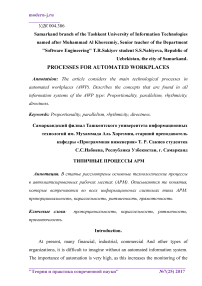Processes for automated workplaces
Автор: Sakiyev T.R., Nabiyeva S.S.
Журнал: Теория и практика современной науки @modern-j
Рубрика: Основной раздел
Статья в выпуске: 7 (25), 2017 года.
Бесплатный доступ
Annotatsion: The article considers the main technological processes in automated workplaces (AWP). Describes the concepts that are found in all information systems of the AWP type: Proportionality, parallelism, rhythmicity, directness.
Proportionality, parallelism, rhythmicity, directness
Короткий адрес: https://sciup.org/140272042
IDR: 140272042
Текст научной статьи Processes for automated workplaces
Introduction.
At present, many financial, industrial, commercial And other types of organizations, it is difficult to imagine without an automated information system. The importance of automation is very high, as this increases the monitoring of the fulfillment of obligations and ensuring timely payment of taxes to the budget. Calculations with the help of an automated system lead to a rapid decrease in the cost of production and sales of products. The process of selling products produced by the organization in its activities is very important, because as a result of the speed of this process, the organization covers its expenses and pays taxes to the budget and also pays in due time credits and receives the opportunity to pay. Regardless of the differences in the use of transactions, there are model principles And the general logic of the organization of the technological process on AWP of all types.
Properly organized production process must meet the optimal parameters for the speed of operations, ensure data integrity, cost-effectiveness and a high level of logistics services.
The fulfillment of the assigned tasks is possible if the following principles of organization of material flows in production are strictly observed:
-
- Proportionality;
The interrelated operations of the production process must be performed proportionally, that is, they correspond to each other in terms of throughput, productivity or speed. Quite often, there are situations when the above principle is left without attention, which can lead to unnecessary costs.
-
- Parallelism;
Simultaneous execution of independent operations at all stages of the process. It contributes to an increase in the rate of work load, a reduction in the cycle of work and the efficiency of workers' labor.
-
- Rhythmicity;
Repeatability of individual operations and the whole cycle in equal time intervals is a prerequisite for the constant expenditure of time, energy, labor throughout the whole working day. The lack of rhythm in the process often depends not only on the work of production, but also on some external factors: Vehicles, uneven arrival of production materials. It is necessary to strive for the rhythm of the receipt of goods and the corresponding rhythm of their leave.
-
- Directness.
Means the maximum rectification of technological paths of data movement, both in vertical and horizontal directions.
Conclusion
To ensure substantial control over the integrity of material values, the organization of the working process in organizations is of no small importance. All the activities of the service enterprise should be aimed at achieving the objectives of meeting the needs of the population in various services and profit extraction, for which it is important to use modern principles, methods and forms of organization of the performance of production services.
Sources
-
1. VM Weizman. Automated Development of Corporate Information Systems: Textbook. Allowance. - Yaroslavl: MUBINT, 2003.
-
2. David A. Mark and Clement McGowan, "Methodology of Structural Analysis and Design of SADT", 2005.
-
3. Ivanova GS Technology of Programming: Textbook. For universities. - 2 nd ed., Sr. - Moscow: MSTU them. NE Bauman, 2003.
Список литературы Processes for automated workplaces
- VM Weizman. Automated Development of Corporate Information Systems: Textbook. Allowance. - Yaroslavl: MUBINT, 2003.
- David A. Mark and Clement McGowan, "Methodology of Structural Analysis and Design of SADT", 2005.
- Ivanova GS Technology of Programming: Textbook. For universities. - 2 nd ed., Sr. - Moscow: MSTU them. NE Bauman, 2003.


